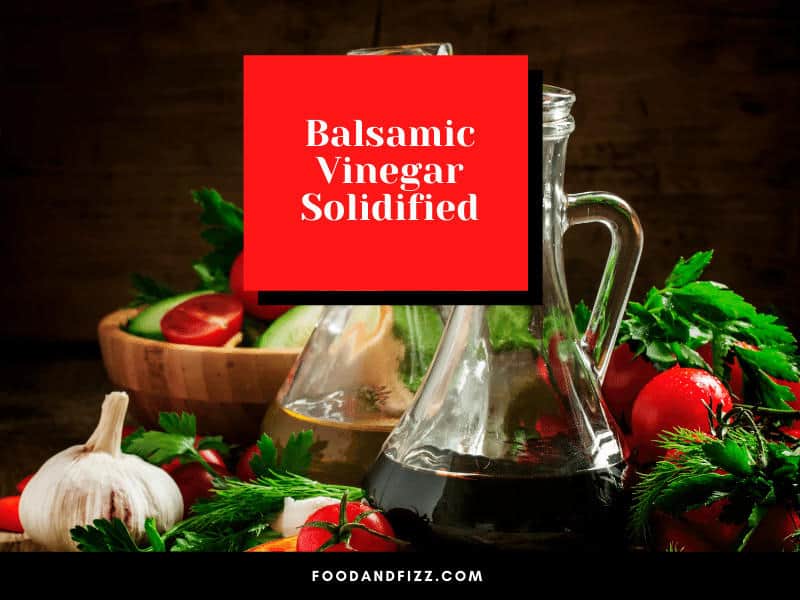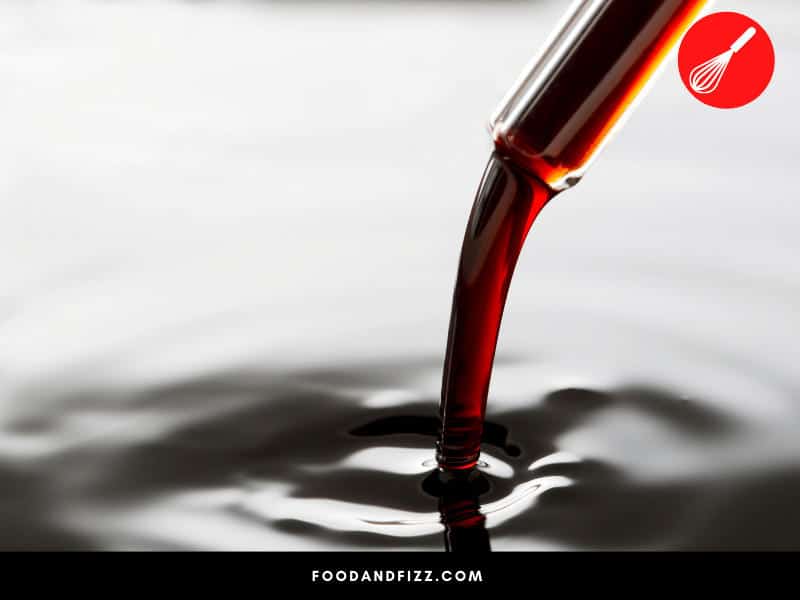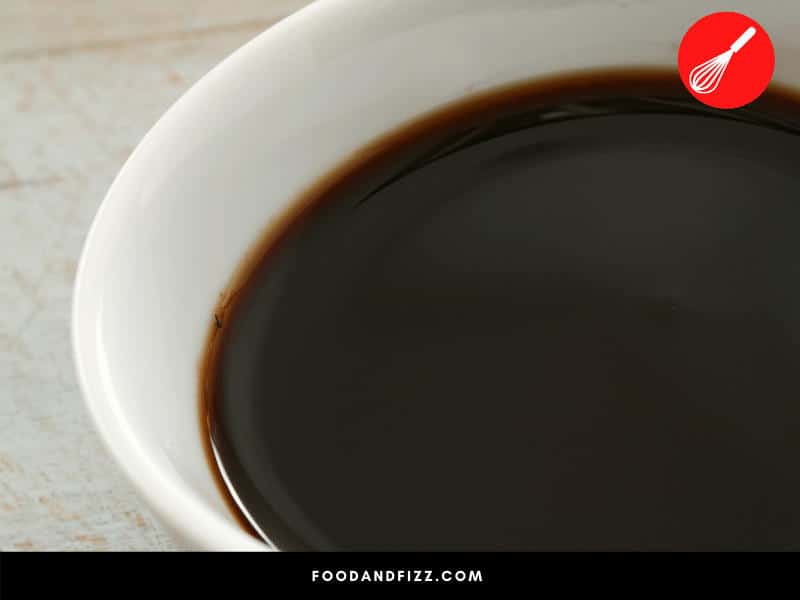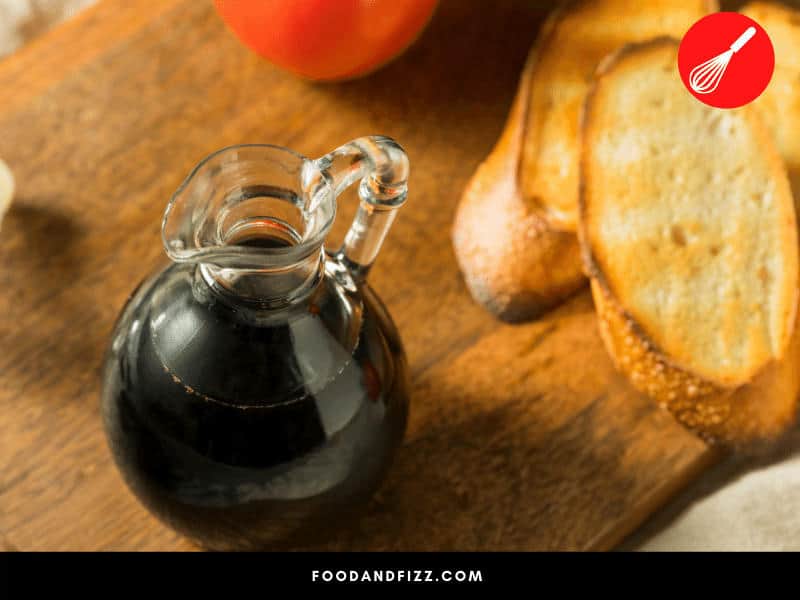Do you have a bottle of balsamic vinegar in your fridge or pantry that you reach for occasionally to make a nice dressing?
If so, perhaps you’ve reached for it only to find something solid floating in it.
If balsamic vinegar solidified, don’t worry!
Those solidified bits won’t hurt you, and they may be your key to a whole new world…of vinegar making. Read on to find more about vinegar “mothers” and how to salvage your go-to bottle of balsamic.
Balsamic Vinegar Solidified
If your balsamic vinegar solidified in the refrigerator, it might just be cold. Warm it up and shake it. If it smells OK, you’re good to go. But the solids might also be the forming of a vinegar “mother,” a raft of bacteria that turn alcohol into acetic acid with the help of oxygen. This “mother” is not harmful. Either filter it out and toss it, or transfer it to a new container and feed it with wine to start your own vinegar.

Vinegar Explained
You probably already know that vinegar is a family of acidic liquids often used as a condiment.
Vinegars usually come from wine (red or white), malt, rice, or cider. In each case, yeast feed on the sugars or starch in a liquid from a plant (like grapes, rice, or apples).
This liquid ferments into alcohol. Then, acetic acid bacteria transform ethanol and oxygen during a second fermentation process to turn the alcohol into vinegar.
As long as these bacteria remain, the process can continue—that’s why solids can form in your vinegar!
The US Food and Drug Administration requires that vinegar contain four to eight percent acetic acid, which accounts for the pungent smell and taste we love.
That tartness is where vinegar gets its name, which comes from old French words for “sour wine.”
To reach that special point can take months and even years of fermentation. Traditional balsamic vinegar can be aged for 25 years!

Balsamic Vinegar: From Tradition to Table
Traditional balsamic vinegar comes from the Modena region of Italy. There, balsamic vinegar is made exclusively from grape must.
As the grapes ferment, and the liquid evaporates, a sweet, savory, syrupy liquid forms that incorporate flavors of the barrels it’s aged in. This process can take years.
The result is a small and expensive product used mostly as a garnish—cooking would ruin the taste that took years to perfect.
That traditional vinegar is unfiltered and unpasteurized (the process that kills off bacteria), so much more likely to form solids over time.
By contrast, supermarket balsamic vinegar is made by combining grape must with wine vinegar to speed up the fermenting process and increase the amount.
Supermarket balsamic vinegar is also more likely to be pasteurized, because the solids that form from the bacteria in vinegar, though not harmful, are not pleasant for most consumers.

The “Mother” of All Vinegars
Unpasteurized vinegars of all types, including balsamic vinegar, can if left long enough, begin to solidify or form a slimy skin.
Over time, these solids will congeal into a mass that looks like some kind of internal organ. This mass is called a “mother.”
The “mother” is so-called because it’s like an engine for creating vinegar.
A piece of this collection of bacteria, if placed in a crock or a jar and fed with wine, will turn that wine into more vinegar. It will also grow larger.
You can then break off more pieces to share with friends!
While this may sound like the plot of a horror movie that is not for the squeamish, many home cooks swear by the vinegars they can create this way.
Like other do-it-yourself homebrews, homemade vinegar can be adjusted to your preferred acidity level and flavor. And of course it’s cheaper than Aceto Balsamico Tradizionale di Modena.

How to Evaluate Balsamic Vinegar
If you’re looking to replace that bottle of balsamic vinegar that’s been in the pantry long enough to form some solids, here are some tips for choosing among the options:
- The Label – A seal on the label that says Protected Geographical indication means the vinegar comes from the traditional balsamic producers of a particular region in Italy
- Ingredients – If the bottle includes ingredients other than grape must and wine vinegar, they may be artificial flavorings meant to hide the fact that it’s not really balsamic vinegar
- Ingredient order – If the first ingredient is grape must, the balsamic vinegar will be sweeter. If the first ingredient is wine vinegar, it will be more tart.
- Thickness – An good balsamic should have a syrupy viscosity already that clings to the side of the bottle if you shake it
Like wine, vinegar (balsamic and otherwise) comes in different types and brands that appeal to different people. Try it and see what you like!

Frequently Asked Questions About Balsamic Vinegar Solidified
Is it safe to use vinegar after solids have formed?
If your vinegar has formed solids, use these questions to determine if it is safe to consume:
Has the vinegar been in the fridge? (If so, it might just be cold. Try warming it up and shaking it to re-liquefy)
Is the vinegar pasteurized? (If so, it’s less likely—though not impossible—that the solids are the formation of a vinegar “mother”)
Does the vinegar smell bad? (Your body knows when food is “off”—trust it)
How should I remove the solids from my vinegar?
To remove any sediment or bits of vinegar “mother” that may have formed in your unfiltered or unpasteurized vinegar, simply pour it through a coffee filter into a clean container. Discard the solids, and then pour the filtered vinegar back into your bottle.
Can I heat up my solidified vinegar to liquefy it?
If your vinegar was in the refrigerator and got a bit thick, leave it on the counter to warm up. Don’t heat your vinegar on the stove unless you plan to use it right away. Heating the vinegar will actually increase or activate the bacteria in the vinegar, potentially leading to more solids. It will also change the taste and texture. That’s fine if you want a nice balsamic glaze, but not if you just want thinner vinegar.

